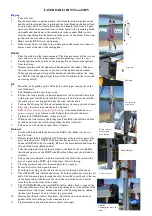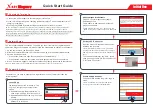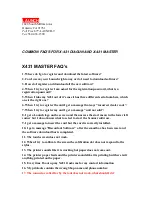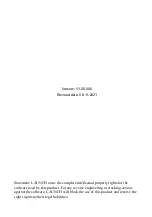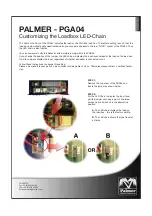
P
APILL
ON P
AR
A
GLID
ER
S
|
HIM
AL
A
Y
A
|
O
W
N
ER´S M
ANU
AL
10
|
20
RAPID DESCENT
In any situation where you have to get down ASAP for different reasons (e.g. thunderstorms, extreme updraft or other dangers) there are a couple of
techniques to do so:
„BIG EARS “
An important and in many cases recommend-
ed rapid descent method is called “Big Ears“.
By pulling on the outer A-lines, the “ears” of
the paraglider (usually two to four cells) are
collapsed. The sink rate increases, while the
airspeed remains approximately constant.
This can help, for example, to escape cloud
suck, whereas in a spiral the paraglider would
still remain in the area of suction under the
cloud.
Both designated outer A2-risers (grab at or
above the quick links) are being pulled down
simultaneously 15-20 cm to fold in the wing
tips. The brake toggles are to be held in hand
together with the pulled down A-lines.
For additional stability and for an increased
sink rate the speed system should be actu-
ated. The glider remains fully steerable by
weight shifting and descends at an elevated
sink rate (4-7m/sec, depending on how many
cells are folded in).
Once the A-risers are released, the folded
wingtips re-inflate automatically, if not, you
may pump the brakes gently.
Due to the high wing load “big earing” is a
very stable flight condition even in turbulent
conditions. Please be aware that you reduce
the trim speed during “big ears”, but this can
be compensated by applying the speed bar.
Since the wing loading increases and the
airspeed remains roughly the same due to the
greater drag, the stall speed increases.
The PAPILLON
HIMALAYA shows an unprob
-
lematic behavior during this maneuver.
B-STALL
This maneuver offers the possibility to de-
scend comfortably and safely: By pulling down
the B-risers the wing is folded along its lateral
axis and thereby stalled, which causes a sink
rate of about 6 to 9 meters per second.
Entry
Keep the brake handles in your hands, sit up
and take the B-risers. Make sure that really
the B-risers are taken and not the C-risers.
This could happen if a pilot incorrectly starts
counting from the trailing edge instead of the
leading edge of the wing.
With the PAPILLON
HIMALAYA the B-risers are
labelled to avoid confusion.
The B-risers are pulled down slowly, thus
slowing down the entire paraglider. After a
pull of about 15-20 cm the stall occurs. Slowed
down like this, the canopy barely falls behind
the pilot with an increasing sink rate.
The maneuver
Look immediately upwards, if the desired
B-stall occurred. Then look down to control
the loss of altitude and the area below you.
Then alternately look upwards and down
-
wards.
In case of an atypical deformation of the
canopy, immediately release the B-risers and
recover from the maneuver. A slight turning
tendency is normal, because the maneuver
often cannot be initiated 100 percent symmet
-
rical. The wind may also have an influence. If
the change in direction feels unpleasant, just
recover and repeat the maneuver.
Recovery
By a quick, but most importantly symmetrical
release of the B-risers, the maneuver is termi
-
nated. The canopy dives forward to reattach
the airflow and end the stall. Do not prevent
this pitching forward by braking. Pilots with
an active flying style tend to stop this desired
pitching moment.
The difference of the forward pitching mo
-
ment after a B-stall and the pitching moment
after a thermal flight is that the paraglider
needs to accelerate after a B-stall while it
simply swings back and forth in the turbulenc
-
es caused by thermals.
Summary of Contents for HIMALAYA
Page 1: ...HIMALAYA OWNER S MANUAL ...



























